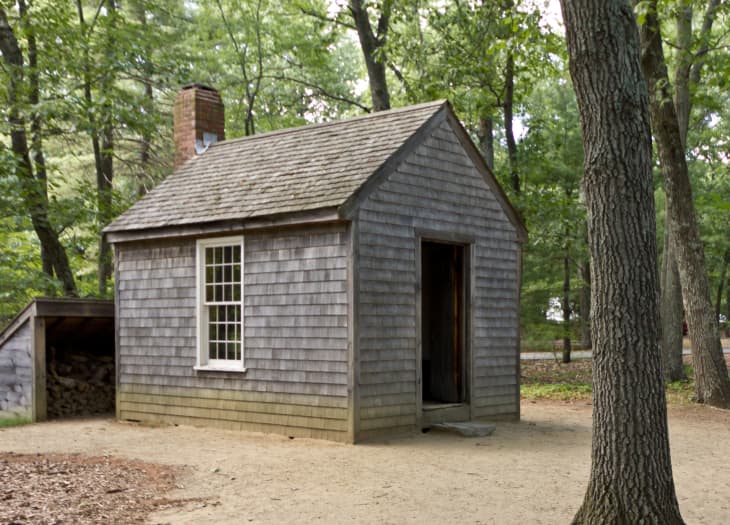Henry David Thoreau Built the Original Tiny House

Although our generation sometimes acts like they invented the Tiny House, the idea has been kicking around essentially since the invention of the house itself, to be periodically rediscovered by people enamored with returning to a simpler existence. In 1845, Henry David Thoreau, who was then 28, began what would be a 2-year experiment in living simply and retreating (well, mostly) from society and its materialistic ills. He moved to the shores of Walden Pond, and built himself a tiny house.
Not opposed to getting a helping hand, this rugged individualist camped out on the property of his friend Ralph Waldo Emerson, where he constructed a rugged one-room cabin from materials that cost him 28 dollars and 12 1/2 cents*, including a thousand bricks for four dollars and two casks of lime for $2.40, which he felt to be too expensive. (Adjusted for inflation, this comes out to $878.52 in 2018 dollars, although the calculator I used would not let me add half a cent.)
- Boards………………………………… $ 8.03-1/2; mostly shanty boards.
- Refuse shingles for roof sides… 4.00
- Laths…………………………………… 1.25
- Two second-hand windows
with glass…………………………….. 2.43 - One thousand old brick……….… 4.00
- Two casks of lime……………….… 2.40 That was high.
- Hair…………………………………..… 0.31 More than I needed.
- Mantle-tree iron……………….….. 0.15
- Nails…………………………….…….. 3.90
- Hinges and screws………….……. 0.14
- Latch…………………………….……. 0.10
- Chalk……………………….…….…… 0.01
- Transportation………..…………… 1.40 I carried a good part on my back.
In all………………………………… $28.12-1/2
*Materials list and pricing information sourced from Walden
Many of the boards used to build the house came from an old workman’s shanty, which Thoreau purchased for $4.25 and carted to his building site. Others came from felling trees on the site. Thoreau did most of the work himself, although he did have the help of a few friends, “rather to improve so good an occasion for neighborliness than from any necessity” (a very Thoreau sort of thing to say).
The design of the cabin was very simple: just one room, 10 feet wide and 15 feet long, with a hearth at one side. Thoreau did all his cooking there, or outside, and presumably answered the call of nature while communing with nature. The outside of the house was clad in shingles, to keep it weathertight, and the inside plastered.
Like a lot of modern tiny house dwellers, Thoreau moved on from his experiment in small-space living: he abandoned the house after two years. Also like a lot of modern tiny house dwellers, he wrote an account detailing his experiences, which became Walden, Thoreau’s enduring paean to simple living and self-reliance.
After he left it, Thoreau’s little house presumably fell victim to the ravages of nature and time, although if you visit Walden Pond, you can still see the site where the cabin once stood, surrounded by stone markers. Walk inside them and you can see Thoreau’s original hearthstone. (One of the stone markers claims that the site of the cabin was re-discovered in 1945, but that seems to contradict this photo, which shows the site marked by a cairn in 1908.) There’s also, in a slightly different location, a re-creation of the original cabin, furnished as it would have been while Thoreau lived there. It’s a neat little piece of history, and also a reminder of the timeless appeal of the simple life.
For Further Reading:
• The Historic House Blog has a lengthy excerpt from Walden, where you can read about the process of building the cabin in Thoreau’s own words.
• Want to plan a visit to Walden Pond? New England Today has lots of info. There’s even a beach!
• At Fiddlers Green, you can buy a kit (for a mere $4.95) to make a paper model of the Walden cabin, which might be the most adorable damn thing I have ever seen.